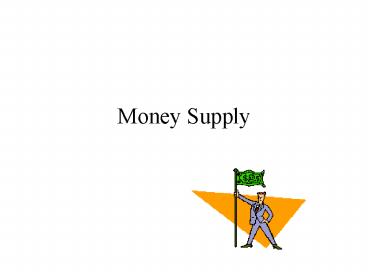Money Supply - PowerPoint PPT Presentation
1 / 21
Title:
Money Supply
Description:
Money Supply Learning Objectives Review the money supply expansion process. Learn how to derive the M1 model. Understand how the interaction of the money multiplier ... – PowerPoint PPT presentation
Number of Views:1568
Avg rating:3.0/5.0
Title: Money Supply
1
Money Supply
2
Learning Objectives
- Review the money supply expansion process.
- Learn how to derive the M1 model.
- Understand how the interaction of the money
multiplier and base determine M1. - Understand the role of the Federal Reserve, the
commercial banking system, and the non-bank
public in the money creation process.
3
The Money Supply
- M1 Currency travelers checks checkable
deposits - M2 M1 small time deposits overnight
repurchase agreements overnight
Eurodollars money market mutual fund
balances - M3 M2 large denomination time deposits
term repurchase agreements term
Eurodollars institutions only money
market fund balances
4
The Creators of Money
- The three major players whose decisions and
actions determine the rate of growth in the money
supply are - The Federal Reserve (Fed)
- Sets reserve requirements
- Operates the discount window
- Engages in open market operations
- The Commercial Banking System
- Accepts deposits and makes loans
- Sets excess reserves
- The Non-Bank Public
- Holds either deposits or cash
5
Money Creation
- Banks create money in their normal, day-to-day
profit seeking activities - Banks do not try to create money
- Money creation occurs because we have a
fractional reserve commercial banking system. - Banks must hold a fraction of their deposits idle
as reserves. They may lend the remainder. - As they make loans, new deposits are created,
causing the money supply to expand.
6
Bank Reserves
- Total Reserves Required reserves plus excess
reserves - Required reserves Deposits times reserve
requirement - Excess reserves Total reserves minus required
reserves
7
Money Creation Summary
New Deposit Required Reserves Excess
Reserves New Loan
100
100
100 10.00
90 90 90
9.00
81 81 81
8.10 72.90
72.90 72.90
7.29 65.61
65.61 65.61
6.51 59.05
59.05
1,000 100
900 900
8
The M1 Model Derivation
- Definitions
- M1 D C
- Base R C
- Total Deposits D
- Assumptions
- r R/D required reserve ratio for deposits
- e E/D the excess reserve ratio
- c C/D the ratio of currency to deposits
9
The M1 Model Derivation
- Model
- B R C
- R rD E
- D D
- C cD
- E eD
- B rD eD cD
- B D(r e c)
1 ( r e c)
D
B
10
The M1 Model Derivation
- Model
- M1 D C
- M1 D cD
- M1 D(1 c) Factor out D
- M1 1 c
r
e c
B
- M1 Multiplier x Base
11
Money Multiplier Terms
- Changes in r
- If r increases, the multiplier decreases
- If r decreases, the multiplier increases
- The money multiplier and M1 are negatively
related.
12
Money Multiplier Terms
- Changes in c
- If c increases, reserves drain from the banking
system. - Fewer reserves mean less expansion of deposits.
- If c decreases, reserves in the banking system
increase. - More reserves mean more expansion of deposits.
- The money multiplier and M1 are negatively
related.
13
Money Multiplier Terms
- Changes in e
- An increase in e means banks are holding more
excess reserves and lending less. - A decrease in e means banks are holding fewer
excess reserves and lending more. - The money multiplier and M1 are negatively
related.
14
The Money Supply Summary
- The money supply equals the monetary base times
the money multiplier - The monetary base (base) is defined as
- Base Reserves Currency
- Base can be controlled by the Federal Reserve
- The multiplier reflects the ability of the
banking system to expand deposits - The multiplier 1 c/(r e c)
- The value of the multiplier is determined by the
Fed, banks, and the members of the non-bank
public.
15
Open Market Operations
Fed Bank Presidents
Securities Dealers
Change in Reserves
Change in Money Supply
Federal Open Market Comm.
Federal Reserve Bank of New York
Commercial Banks
Fed Board of Governors
16
Open Market Operations
- When the Fed buys Treasury bonds from a bank, it
pays for the bonds by crediting the bank with an
increase in reserves. - When the Fed sells Treasury bonds to a bank, it
accepts payment for the bonds by debiting the
banks reserve position at the Fed
17
Discount Loans
- When the Fed makes a discount loan to a bank, the
bank is credited with an increase in reserves. - When a bank repays the Fed, the banks reserves
are debited.
18
Reserve Requirements
- If the Fed increases reserve requirements, banks
have fewer excess reserves to lend, causing the
expansion of deposits to decrease. - If the Fed decreases or eliminates reserve
requirements, banks have more excess reserves to
lend, permitting the expansion of deposits to
increase.
19
Excess Reserves
- Banks determine the level of excess reserves
- Increases in excess reserves diminish the
expansion of deposits. - Decreases in excess reserves increase the
expansion of deposits
20
Currency Drains
- Members of the non-bank public determine currency
in circulation - Increases in currency drains from the banking
system, diminish the expansion of deposits - Decreases in currency drains from the banking
system, increase the expansion of deposits
21
Central Bank Policy Channels
Cost Availability of Credit
Full Employment Growth Price Stability
Policy Tools
Volume and Growth of Borrowing
and Spending by the Public
Size and Growth Rate of Money
Supply
Level Growth Bank Reserves
Market Value of Securities

